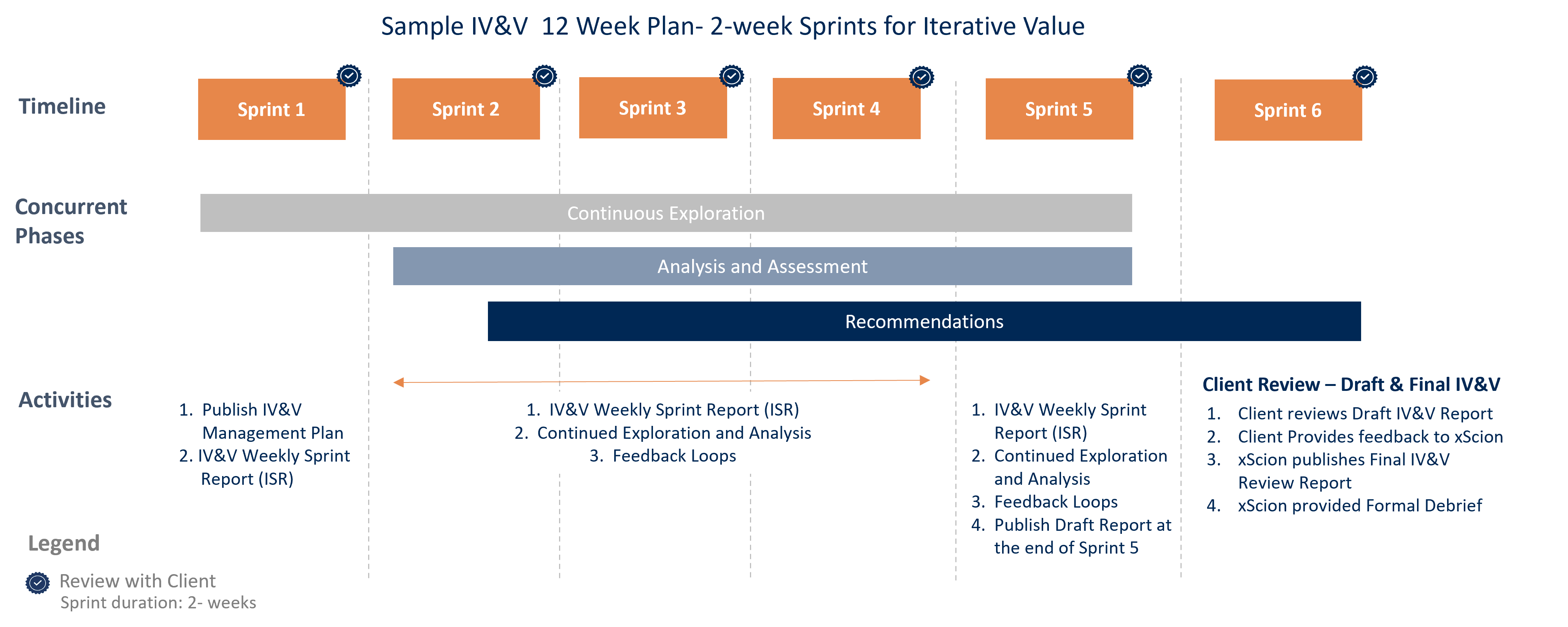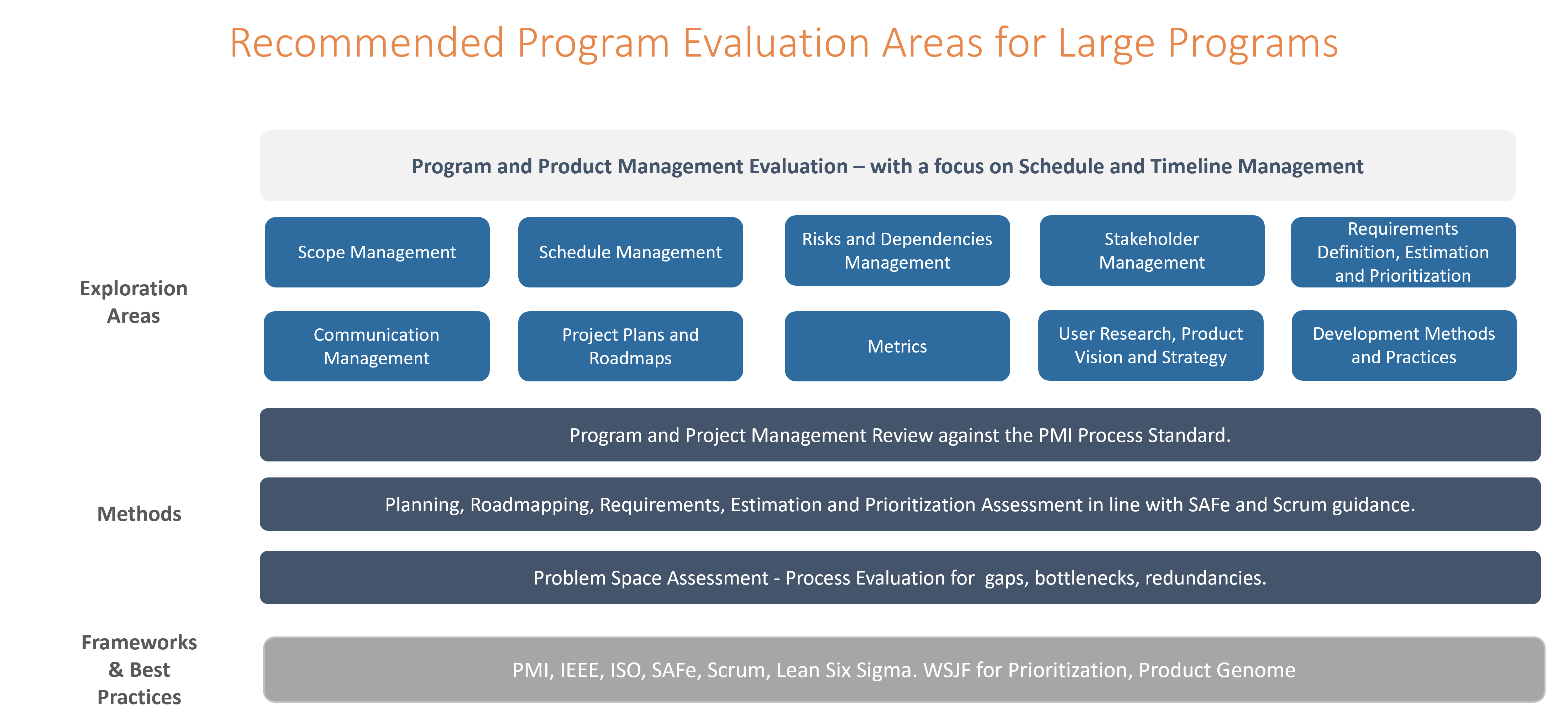What is Large Program IV&V?
Organizational transformations of your processes, technology and teams benefit from Independent Verification and Validation (IV&V) assessments that verify the process and validate that new products, systems or services meet your customer or Stakeholder needs. IV&V support throughout a transformation ensures your strategy and execution lead to on-time, on-budget and successful outcomes.
Yet every transformation is unique – some are small programs and projects that require rapid, short-term IV&V support, while others are large, long-term, multi-year programs that require ongoing IV&V engagement.
Long-term programs truly benefit from Large Program IV&V’s ongoing assessments that occur at different milestones throughout the phases of the transformation lifecycle. Starting early and continuing iteratively provides teams with recommendations, improvements and guidance from the program’s beginning and validates the implementation of these recommendations as the program moves from phase to phase.
As your organization continues to undergo large transformations, Organizational Change Management aligns your teams and culture to your Future State goals, while Agile IV&V quickly mitigates your risk in the Current State.
The Value of Agile IV&V
Ensuring Independent Perspectives
Utilizing teams of IV&V experts that bring an independent perspective is crucial to providing objective and impartial analysis and feedback. The Institute of Electrical and Electronics Engineers (IEEE) defines independence across three parameters – Technical, Managerial and Financial independence – to ensure objectivity. Furthermore, using an Agile approach allows IV&V teams to maintain independence while effectively collaborating with clients to produce high quality results.

Technical Independence
Technical Independence requires that IV&V personnel not be involved in any stage of the software requirements, design or development process. The IV&V teams offer a fresh perspective that can detect subtle anomalies that those too close to the solution might overlook.

Managerial Independence
Managerial Independence requires that IV&V responsibility be vested in an organization that is separate from the Development and Program Management organizations. The independent selection of the artifacts to be examined and tested, the techniques to be used, the issues to be chosen and the reporting to be made further affirm this independence, allowing the IV&V team to report results, anomalies and findings without restrictions, or adverse pressures, direct or indirect, from the Development team.

Financial Independence
Financial Independence requires that the IV&V budget be vested in an organization independent from the Development organization and is necessary to maintain technical and managerial independence.
Using Agile IV&V Methodologies Provide Quick, Continuous Feedback
Agile IV&V augments traditional IV&V methods by utilizing Scrum, Lean, Product and Agile practices to provide greater transparency, faster feedback and a continuous loop of communication with your teams. As a result, you can achieve quicker remediation of issues identified during the IV&V process. IV&V teams can also be embedded with your Process and Technology teams to provide expedited, real-time feedback and remediation.
Assessing Three Key Transformation Areas
Agile IV&V is the perfect method to analyze and recommend improvements across the three key areas that are part of any transformation: Process, Organizational Change Management (OCM) and Technology. This end-to-end view of IV&V can be conducted to ensure a successful transformation that is on time and on budget. These include:

Process
Agile, Product and DevOps Adoption Assessments that leverage industry frameworks such as SAFe, Scaled Agile, PMI, Scrum and others

OCM
Resource, Role and Management Change Evaluations that leverage PROSCI and other industry frameworks

Technology
Technology Migration, Adoption and Scaling Evaluations that focus on new Architectures, Automation opportunities and Cloud-native technologies
Common Challenges Addressed by Large Program IV&V

People and Scale
Large Programs cross organizational boundaries, Management teams and Stakeholder groups. It is necessary to have alignment, agreement on business outcomes and robust collaboration among Stakeholders. Large Program IV&V can help ensure disparate groups of Stakeholders maintain alignment with organizational business objectives.

Visibility
Lack of visibility among teams can lead to undefined and unresolved dependencies. Cross-team, cross-unit dependencies must be clearly mapped and considered during project planning. Large Program IV&V can recommend best practices such as using Program Boards and Portfolio Kanban to enhance visibility where needed.

Planning
For Large Programs, planning and roadmapping is done at multiple levels to meet short-term, near-term and long-term objectives. Lack of planning and roadmapping can lead to schedule slippages and missed timelines. Lack of decentralized decision making also leads to issues in planning as ground-level views can be ignored. Large Program IV&V can ensure consistent planning and roadmapping that includes perspectives from all levels to keep work on schedule.

Communication and Collaboartion
For Large Programs, communication and collaboration among disparate teams are vital. Communication gaps can lead to timeline failures or wasted effort. Large Program IV&V can facilitate collaboration by directing focus to multiple Value Streams that provide opportunities to map dependencies and foster collaboration.

Problem Space Awareness
It is crucial to understand end users in order to have a clear view of the problems to address before proceeding to program solutions. A clearly defined Problem Space is necessary to know the needs of your users and is fundamental for creating a Product Vision and Strategy. A poor understanding of the Problem Space can lead to a mismatch between expectations and deliverables. Large Program IV&V can validate your understanding of the Problem Space early on with additional expert perspective. This will ensure your program gets off to a strong start and remains grounded in a well-defined understanding of the Problem Space across Stakeholders throughout the transformation.

Process
Gaps, inconsistencies and redundancies in key Program and Project Management processes such as Scheduling, Scoping, Planning, Risk and Dependencies, Stakeholder and Communication Management, etc. lead to delays and overhead. Large Program IV&V can identify issues and provide remediation at key phases throughout the transformation.

Collaboration with Shared Services
A lack of alignment among Development and Infrastructure/Shared Services units can lead to delivery issues. Large Program IV&V can identify issues and recommend appropriate interventions such as embedding Infrastructure and Shared Services members within Development teams or establishing a dedicated team focused on solutions to help avoid delays.

Metrics
Well-defined metrics, firmly rooted in the core problems, help track meaningful progress towards the expected business outcomes. Not having a robust metric system can negatively impact delivery timelines. Large Program IV&V can provide insight from industry best practices to recommend appropriate metrics aligned with business outcomes to ensure timely delivery of value.

Requirements, Estimation and Prioritization
Unclear requirements, gaps in Product Backlog items such as not having a well-defined hypothesis statement, lack of leading indicators to measure real progress, and absence of estimation and prioritization mechanisms can lead to too many things being worked on in parallel and result in capacity planning issues. Large Program IV&V can identify gaps and clarify requirements to streamline and prioritize workflows.
Example of Large Program IV&V
An Agile approach to executing Large Program IV&V is comprised of smaller Agile IV&V engagements carried out at multiple integration points or milestones throughout the Large Program’s lifecycle. These integration points provide focused Recommendations to optimize the Program Execution phases.
After an initial 12-week engagement, the IV&Vs are conducted on demand and can have varying scopes and timing. For example, gaps between two consecutive IV&Vs can occur at different intervals, depending on Program needs.
Each new IV&V starts with a health check on the results of Execution from the previous IV&V Recommendation. Since the IV&V starts delivering Recommendations early and on an iterative basis, it can run concurrently with Program lifecycle phases to ensure successful delivery.
What Happens in Each Individual Agile IV&V Engagement?
A concurrent, three-phase approach is used to deliver value quickly and iteratively throughout the engagement.
Phase 1: Continuous Exploration (Sprints 1-3)
Phase 2: Analysis and Assessment (Sprints 2-4)
Phase 3: Recommendations (Sprints 3-6)
Phase 1: Continuous Exploration
In this example, Continuous Exploration is carried out during Sprints 1-3. Current State and Gap Assessments are conducted using the following methods:
• Walkthrough and introductory sessions by subject matter experts
• Stakeholder interviews using checklists, open-ended questions and document reviews, as needed
• Review of Project, Scope, Schedule, Resource, Financial, Communications and Requirements artifacts
• On site or virtual Gemba walks
In addition, an IV&V Management plan is developed that includes a detailed plan of action with dates, deliverables and other relevant information as a roadmap to guide the engagement.
Phase 2: Analysis and Assessment
Analysis and Assessment is carried out during Sprints 2 – 4. Documentation and Stakeholder feedback are analyzed using domain expertise, applicable checklists and tools. The analysis provides a foundation for focused Recommendations provided in Phase 3. Key activities to better understand the Problem Space include:
• Identification of gaps, bottlenecks, conflicts and opportunities
• Evaluation of Project and Program Management approaches
• Evaluation of compliance with relevant standards and processes
• Exploration of the needs, issues and aspirations of users/teams
• Evaluation of current processes
• Identification of gaps in capabilities and functions
• Assessment of requirements alignment with broader business objectives
Phase 3: Recommendations
Recommendations are designed to address gaps identified during the IV&V engagement, as well as validate current use of industry best practices. Using Agile principles, Recommendations are delivered iteratively throughout the engagement. Preliminary findings are shared through Sprint Reports after each Sprint.
This early feedback loop is meant to enhance collaboration between the IV&V team and your team, as well as ensure a better Final Recommendations Report with no surprises at the end of the engagement. The goal of all the Recommendations are to improve the efficiency of current practices, fill any gaps identified, remove impediments and ensure closer adherence to standards and processes.
Recommended Program Evaluation Areas for Large Programs
Ensure Your Transformation’s Success with Large Program IV&V
Large and complex transformations of processes, roles and technology need a relentless focus on continuous improvement at each stage of the Program Lifecycle to achieve the best results and meet desired business outcomes. Working with an independent partner ensures your transformation efforts stay on course to optimally achieve organizational objectives and business outcomes.
xScion’s Large Program IV&V uses Agile methodology to engage, from the beginning and throughout your transformation, on demand at key phases identifying areas for improvement and helping your organization implement Recommendations and guidance as you go. Learn more about xScion’s Large Program IV&V partnership and how we can help your organization Turn Change Into Value®.

Full Transformation Support
Fact-based IV&V analysis for all types of transformation projects, including Process, Organizational Change Management (OCM) and Technology.

Deep IV&V Expertise
Our experienced IV&V teams are comprised of deeply-skilled experts who have supported multiple IV&V engagements and possess deep institutional and technology knowledge.

IV&V Support for All Project Sizes
IV&V expertise to fit your project needs, from Rapid Engagements to Large, Multi-year Programs.

Additional Full Digital Transformation Support
Solutions and consulting services including Agile, Cloud, Product Management, Automation and Risk.

Agile IV&V Methodology
Delivers quick, actionable insights starting at Sprint 1, by providing Recommendations early, often and in an iterative manner.
Download the Complete Guide to Large Program IV&V
Read More
Ensure Your Large Program Transformation Success with IV&V
Learn how IV&V offers large and complex transformations a relentless focus on continuous improvement at each stage of the Program Lifecycle to achieve the best results and meet desired business outcomes.
Using Agile IV&V: Quickly Mitigate Your Risks with Improved Transparency
Learn how combining traditional IV&V with Agile practices brings collaboration, communication and transparency to the IV&V process.
How Large Program IV&V and Agile Work in Practice
Learn how Large Program IV&V uses Agile methodology throughout your transformation to identify areas for improvement and help your organization implement Recommendations and guidance as you go.
Turn Change Into Value® with Agile IV&V
Learn how IV&V teams can identify opportunities to enhance security and processes or approaches that add value that lasts beyond the IV&V engagement.
Success Stories
Learn how xScion helped a large financial institution develop a roadmap based on industry best practices that accelerated modernization efforts while meeting increased user demand.
Quality Assurance Using Behavior-Driven and Test-Driven Development
Learn how xScion assisted a large health payer digitally optimize their member onboarding process through new Automation processes.
Ready to Turn Change Into Value®?
Our team of experts are ready to help.










